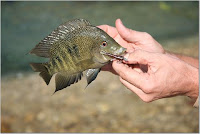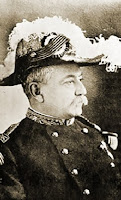A repeat search several weeks ago turned-up some other, fascinating history that corroborates some of the old family legends. More importantly, it started a multi-generational conversation between my cousins and our parents, and even more stories are coming to light.
Geronimo!The Bedonkohe Apache leader figures only tangentially into our story, but he's the reason parts of it were recorded.

In December of 1885, a force of four U.S. Army officers, 40 American packers and 100 "tame" Apaches entered Mexico in pursuit of Geronimo.
Along the way, the Indians under American command engaged in drunk and disorderly conduct, killed several citizens and killed and stole numerous cattle (including two belonging to the prefect of the district of Moctezuma, my great-great grandfather, José María Torres, and one belonging to his brother Gen. -- later Gov. -- Lorenzo Torres).
This became an international incident -- and thus was recorded -- when the commander of the expedition was killed in early Jan. in an exchange with Mexican volunteer troops from the neighboring state of Chihuahua who also were pursuing Geronimo's band.
Some accounts say that the exchange was an unfortunate accident, and that Capt. Emmet Crawford was shot while trying to tell the Mexican troops they had erred. One Mexican officer and five troopers also were killed or wounded in the exchange. Other
accounts offer a different perspective.
At the request of the U.S., the Mexican government initiated at least one (and possibly two) investigation(s) into the incident.
In:
Papers Relating to the Foreign Relations of the United States, Transmitted to Congress with the Annual Message of the President, Dec. 6, 1886 (Government Printing Office), the accounts of what occurred Dec. 1885-Jan. 1886 are remarkably consistent.

The investigation took place in the spring of 1886 and consisted of combing through the records of contemporaneous reports in the various municipalities through which Crawford's force passed and taking new depositions from witnesses. One of those witnesses was my great-great grandfather.
In his deposition in March 1886, José María states for the record that he is 38 years old, a widower, a native of the state of Sinaloa and now a resident of "this place" (Moctezuma, Sonora), living on Plaza Street. On the same date, Lorenzo Torres was not present in the district and could not be deposed.
At the time he gave his deposition, José Maria had only a few months to live. On June 12, 1886, he was murdered by rebels led by Guadalupe Velarde.
The family legend is that he was ambushed on the road from his ranch to town. Whether he was targeted randomly, or as an act of political violence, or because he was the brother of Gen. Lorenzo Torres or Gov. Luis Torres (some accounts say Luis and Lorenzo were brothers, others say they were not related), or for some other reason … I don’t know.
One version takes a sinister view of this event: José Maria's brother (either Luis or Lorenzo) had him killed in order to take his land.
This seems unlikely, as both Luís and Lorenzo were key members of the Porfiriato (Pres. Porfirio Diaz' ruling clique), more prominent than my great-grandfather, and probably already quite wealthy. And, too, we can surmise from the Crawford incident that Lorenzo and my great-great grandfather already shared a ranching enterprise.

My great grandfather, also José María, was only about 5 when his father was killed. According to the family stories, he was taken in and raised by an uncle, who sent him to the
Colegio Militar at Chapultapec.
At some point, probably shortly after he graduated from the academy, he rode across the border and into the United States, where he joined a Wild West Show, possibly the famed 101. In the show he demonstrated his skill with six-shooters, alongside a half-Cherokee fellow named Will Rogers. Family legend says they both dropped out of the show near Caney, Kansas, on the Oklahoma border.
It was there he met the daughter of an inkeeper, Inez Merceda Walker, and they married.
What inheritance?The pieces are coming together, slowly. We still have cousins in Mexico; my mom's generation fell out of touch with them sometime in the 1960s. As late as the 1970s, my great grandfather's portrait still hung on the walls at the Castle of Chapultapec. We know where to look for more information. We can figure this out, and the sleuthing is fun.
But what does it matter? There is no land, no money, no title. My genetic inheritence from my grandfather Ramón is only equal to that I received from my Dutch-Irish-Scottish-Huegonot grandmother, his wife; it's only as much as I received from my Scots-Irish paternal grandfather, and my German-Irish-Mohawk paternal grandmother.
I'm a mutt.
It's tempting to draw lines and say: "Oh, I got this from that person!" And in fact, people say I favor my Uncle Junior, who in turn looked a lot like his dad, my grandfather. But I also really enjoy beer and live music; is that the legacy of my great grandfather on my dad's side? Patrick Henry Reed was a lanky Southern hillbilly, the town drunk and a heck of a fiddler.
I've glommed on to the Mexican side of the family for a couple of reasons; one is proximity: Sonora is just two states over from Texas. The other is recency: ancestors in my other lines immigrated in the 17th and 18th centuries, and I suspect that while we know more about them in broad strokes now, the fine details are lost forever.
The history of my Mexican family also is interesting, in that it reflects to some degree a turbulent period in the history of Mexico and also the American Southwest.
My Aunt Ruth told me once that Lorenzo Torres -- her great uncle -- had moved to San Diego for “health reasons” sometime around 1911. I figure she’s right; he was trying to avoid “lead poisoning,” the sort that is acute and instantly fatal.

His friend and associate for many years, Ramón Corral (who is possibly my own grandfather’s namesake, though it's more likely he was named for his uncle, Ramón Aragon), has variously been described as a sensitive, intellectual man and also as one of the most openly corrupt, ruthless and inept politicians of his time. What is not disputed is that his election as Diaz’ vice president was one of the major factors precipitating the Mexican Revolution. Corral joined Diaz in exile in Paris, where he died.
Another reason my Mexican roots fascinate me is because, from the first time I had to fill out a government form that required (or asked for) Census data, I was confronted with these choices: American Indian, Pacific Islander, Black, Hispanic, White (Not Hispanic).
"White (Not Hispanic)?" White, yes. Not Hispanic? No.
The meaning of family All of this -- and, significantly, deciding to share a life with someone again, moving into a new home, integrating an 8-year-old into that -- has led me to reflect lately on the meaning of family.
I think of my childhood friends Ann and Bill, brother and sister. They looked like brother and sister. Even more strikingly, Bill looked, walked and talked just like his dad. Turns out Ann and Bill were both adopted, from separate families. They weren't genetically related to each other or their parents at all. But there was no doubt that they were all family.
I think of other people I know, people whose "families of origin" are lost to them; many of them have adopted a circle of close friends and extended family members as their "family."
When I worked for Child Protective Services, I saw just about every permutation of family -- good families, bad families, abusive families, created families, foster families, adoptive families, estranged families ... and I concluded that family, like so many things in life, is what you make of it.
Families are people who share ties of duty and affection, people who share a common mythology. And by "mythology," I mean legends, some true and some not.
Family is the people you choose (or choose to remain connected to); family is the stories you share; family is history. And I'm a bit of a nerd when it comes to history. I really dig it.

I have long joked that, given our family’s tradition of military service, I surely had an ancestor at the Alamo. This most recent spate of Internet research may have uncovered him: on the decisive day at Bexar, a Mexican officer in the
Zapadores (Engineer Battalion) died while capturing the only Texian flag (the banner of the New Orleans Greys) to make it back to Mexico with Santa Anna's troops, who were later defeated at the Battle of San Jacinto.
His name: José María Torres.
[
Photos: Cousins in Mexico, taken by an itinerent photographer; Gen. (and Gov.) Luis E. Torres of Sonora, who may or may not be related; Geronimo, about the time of the Crawford expedition; my great grandfather José María Torres and his second wife, Inez Merceda Walker (von Wakker); José María Torres and Emma, my mother's first cousins in Mexico; Ramon Corral, Sonoran politician and last vice president of pre-Revolutionary Mexico; the banner of the New Orleans Greys.]
 Saturday I had the rare privilege of spending a couple of hours on the water with eight wounded warriors at Blanco State Park. The soldiers -- all undergoing medical treatment and various therapies at Brooke Army Medical Center in San Antonio -- were there as part of a "Heroes on the Water" outing.
Saturday I had the rare privilege of spending a couple of hours on the water with eight wounded warriors at Blanco State Park. The soldiers -- all undergoing medical treatment and various therapies at Brooke Army Medical Center in San Antonio -- were there as part of a "Heroes on the Water" outing. The Heroes on the Water program gives these troops an opportunity to get out, almost on their own, for a few hours. Sure, there are therapeutic aspects to kayak fishing -- fine motor skills, balance, strength; it's the sort of thing that is good for anyone to practice, but especially if you're, say, learning to use prosthetic thumbs. Or new legs.
The Heroes on the Water program gives these troops an opportunity to get out, almost on their own, for a few hours. Sure, there are therapeutic aspects to kayak fishing -- fine motor skills, balance, strength; it's the sort of thing that is good for anyone to practice, but especially if you're, say, learning to use prosthetic thumbs. Or new legs. Cabela's donated rods and reels for the outing, and the Blanco American Legion Post provided a late lunch. Blanco State Park staff opened their arms to the group and waived entry fees. Brad and Colleen Harvey of Heart of Texas Kayaks brought the boats. Such generosity is always humbling.
Cabela's donated rods and reels for the outing, and the Blanco American Legion Post provided a late lunch. Blanco State Park staff opened their arms to the group and waived entry fees. Brad and Colleen Harvey of Heart of Texas Kayaks brought the boats. Such generosity is always humbling.























































